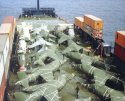To answer you the best way is
Why do they need to carry extra Harriers in the conveyor?
Reinforcements and attrition replacements. When the Task Force sailed they had 20 Sea Harriers between the two carriers, 12 on Hermes and 8 on Invincible. Early predictions of losses were much higher than it turned out (as high as 75%). In total six sea harriers were lost to a mix of ground fire and accidents. 8 Sea Harriers of the newly reformed 809NAS arrived aboard Atlantic Conveyor, 4 were sent to Hermes and four to Invincible, as attrition replacements.
Why Invincible did not carry these harriers from the start of the operations?
Because the Task Force sailed with only 48 hour notice. Prior to that the Fleet Air Arm's peacetime strength was two frontline Sea Harrier squadrons (800NAS and 801NAS) with 5 aircraft each (manned by 8 pilots in each squadron), and the headquarters and training squadron 899NAS based at RNAS Yeovilton equipped with 12 aircraft normally. When the Task Force sailed this sqn was used to bring the two frontline sqns up to 'Wartime' strength, seven joining 800NAS aboard Hermes and three joining 801NAS aboard Invincible (due to the differences in size between the two ships.
The remaining officers and crew of 899NAS left behind then set about rounding up every Sea Harrier pilot then serving on other assignments (exchange tours with the RAF for example) and also bringing the remaining Sea Harrier airframes into service (from storage or maintenance). These Pilots, planes and ground crew were used to reform 809NAS, intended to be a 10 aircraft sqn but only 8 could be supplied. additionally a crash (ie fast) modification programme was applied to at least 10 RAF Harrier GR3s, to provide further attrition replacements. They lacked any radar, but were fitted to fire Sidewinders from their outer wing pylons to supplement the Sea Harriers on CAP. Also tie down points were fitted to the landing gear and other mods to allow them to operate at sea (a highly corrosive environment. Sea Harriers are built with these alterations). Completed in a couple of weeks these 10 Harriers joined the 8 Sea Harriers aboard Atlantic Conveyor after a ferry flight down to Ascencion Island, and after landing on they were wrapped to protect them from the elements on the journey. In short they didn't sail with the Task Force because they weren't ready to.
When the Conveyor was sink did some helicopters were lost?
Yes, Also stored on deck were six Wessex HU5s of 848NAS and five RAF Chinooks of 18 squadron. One Chinook stayed behind on Ascencion Island to help with logistics there, and of the four remaining, one was flown off prior to the ship being attacked. When stored one deck, the Chinooks had their rotor blades removed to save space (they did not and still do not fold), whilst the Wessexes did have folding rotors and folding tails, they were again stored and not easily accessible. There wasn't time to prep any of them for flight and they were all destroyed by the fire. The ship was also carrying a huge amount of material vital to the war effort below decks, including the bulk of the steel matting required to lay a temporary air strip at San Carlos Bay. Only about a quarter of what was sent (which was on another ship) therefore arrived and was set up (named Sid's Strip) and later in the War was used as a refuelling stopover for all the Harriers. The single Chinook that was available was heavily overtasked and the lack of helicopters meant the troops had to walk from san Carlos to Port Stanley. Other equipment was lost too, preventing it from becoming a full forward air base.

Obviously trying to say it is a transport does not hold any waters, the harriers could fly with stores fuel tanks at least, once they lost the conveyor they lost an auxiliary aircraft carrier, not the main carrier, but a ship with the ability to allow landings and takeoffs of Harrier jump jets



